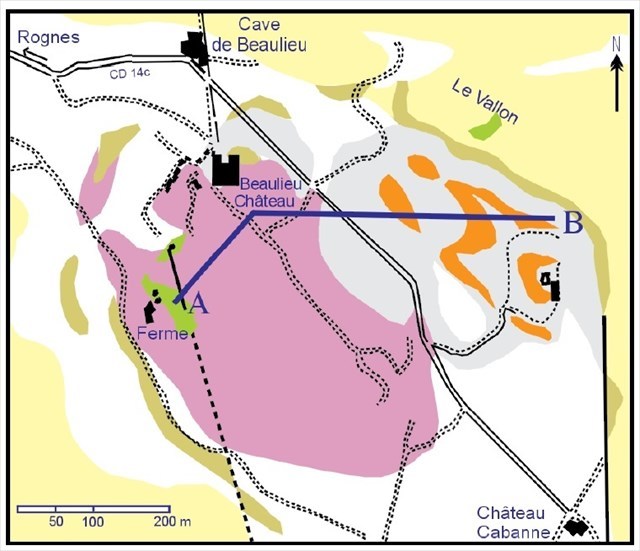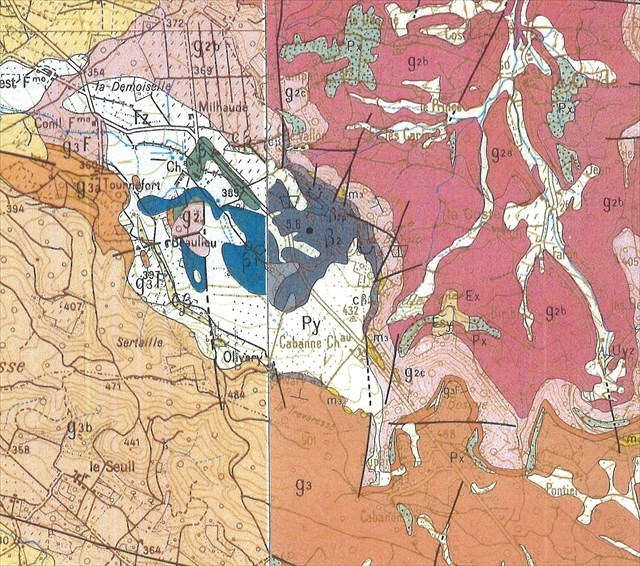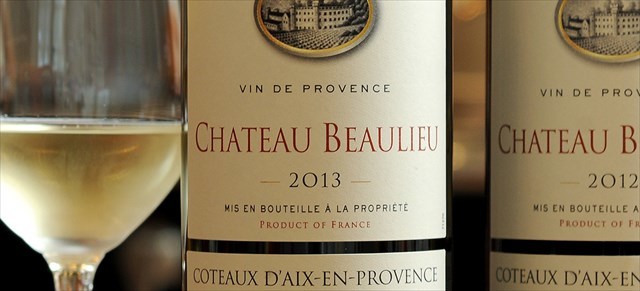DESCRIPTIF EN FRANCAIS (FR) : (SEE ENGLISH DESCRIPTION (EN) BELOW)
Cette earthcache va vous faire découvrir une singularité géologique : les restes d’un volcan sur la commune de Rognes !
UN VOLCAN EXPLOSIF :
Le pointement basaltique de Beaulieu se situe à 2 km environ au SE du village de Rognes, et à 13 km au NW d'Aix-en-Provence. Il est peu visible dans le panorama des collines de la Trévaresse, aucun cône n’est visible, en raison de son relief peu accusé et des nombreuses cultures (= vignobles et céréales) qui se sont installées sur la lave altérée.
Il faut traverser le domaine de Beaulieu en empruntant la RD14c entre Rognes et Puyricard pour prendre conscience de son existence. La superficie occupée par les laves n'excède pas 5 km2. Néanmoins, c'est un des centres volcaniques les plus importants de la Provence occidentale. De toute part, les terrains sédimentaires d'âge tertiaire l'entourent.

Il s'agit en fait d'un volcan "en creux", effondré, dont l'ancien cratère de forme ovale s'est rempli de lave suite à son éruption explosive de type phréatomagmatique (= causée par le contact de la lave avec un milieu aqueux). Ainsi, l'éruption de ce volcan a eu lieu au coeur d'un ancien lac.

Ces éruptions génèrent un fort dégazage, et des colonnes de cendres composées d'un mélange de vapeur d'eau, de particules et de fragments solides (= cendres, bombes...). Mais aussi des nuées déferlantes basales, horizontales, éjectant des blocs de tailles diverses, souvent anguleux, formés de basalte ou de calcaire provenant des terrains superficiels traversés.

Le pourtour du volcan finit par s'effondrer et créer un cratère qui se remplira de lave : on appelle cela un Maar. On ne connait pas exactement la profondeur du lac de lave ainsi formé. 7 sondages effectués en 1968 se sont arrêtés à 80 m, ce qui est son épaisseur minimale, mais les volcanologues n'écartent pas une profondeur de 200 m.

L'analyse de la roche traversée par sondage montre 2 types de basalte : un basalte lourd en profondeur et un basalte léger en surface, représentant la crème du lac de lave.
Le basalte léger est principalement représenté dans la partie N-NE où il a été exploité pour du ballast dans une ancienne petite carrière. L'autre basalte serait lié à une cheminée latérale et la coulée se serait effectuée en partie sous l'eau créant des laves en coussinets.
Les affleurements intéressants existent grâce à d'anciennes exploitations situées dans le domaine privé viticole de Beaulieu. Ces affleurements permettent d'observer une prismation grossière alors que d'autres montrent une altération en boules.

Tout autour des restes du volcan, on retrouve des dépôts issus de cette explosion, constitués d'un mélange de blocs de tailles diverses, souvent anguleux, formés de basalte ou de roches provenant de la cheminée qui s'est ouverte dans les terrains superficiels calcaires.
Une datation radiométrique à 18,2 +/- 0,5 Ma par la méthode K/Ar (= potassium / argon) sur roche totale permet d'attribuer un âge burdigalien (= Miocène) à ce volcanisme. Cette méthode est idéale pour dater des roches volcaniques.
Le basalte de Beaulieu est un basalte alcalin finement cristallisé renfermant de gros cristaux d'olivine (= péridot, minéral souvent vert) et de pyroxène (= minéral ferromagnésien) dans une gangue composée de petits cristaux de feldspath (= silico-aluminate) et d'olivine. On y trouve parfois des enclaves de péridotite (= roche magmatique ferromagnésienne riche en olivine).
Dans les environs, au droit des formations sédimentaires, de nombreux fossiles ont été retrouvés, notamment des os de mammifères divers et variés, des dents de requins, des carapaces de tortues, et de gros os d'Anthracotherium (= apparenté aux porcs et hippopotames).
LE CONTEXTE GEOLOGIQUE :
L’existence de ce volcan est reconnue depuis la fin du 18è siècle par H. de Saussure (= le premier homme à faire l'ascension du Mont-Blanc), qui y remarqua également la présence de fossiles d'animaux terrestres dans les environs. Mais l'intérêt pour ce volcan ne se manifesta que dans les années 1960.
Au Miocène, le domaine de Beaulieu et ses environs faisaient partie du littoral de la Méditerranée occidentale de l’époque. C’est pourquoi on retrouve, dans la région, des dépôts marins de zone peu profonde, des dépôts lagunaires, et des dépôts palustres (= qui se rapportent aux marais).
Il y a 18 Ma, la mer recouvre Rognes envahissant profondément l'actuelle vallée de la Durance. La mer chaude, peu profonde, abrite une riche faune tropicale : requins, dauphins, baleines, coquillages... Au fond de l'eau se dépose un sable argileux, cimenté par une vase calcaire jaune englobant les restes de cette riche faune marine, c'est le Miocène de Provence. Avec le temps, cette boue durcie donne une roche coquillère jaune facile à travailler : la pierre de Rognes, exploitée en carrières pour la construction, ou comme pierre d'ornementation. Alors que cette mer s'étend à perte de vue, le complexe volcanique de Rognes se met en place à proximité du rivage.
Au début du Miocène, la partie centrale de l'actuel bassin d'Aix a été le siège d'un volcanisme alcalin (= riche en sodium et potassium), qui pourrait être le témoin d'un phénomène distensif enregistré par les formations sédimentaires continentales.

Ce contexte distensif est à l’origine de l’ouverture d'un petit bassin océanique provençal sur une ligne de dislocation profonde, orientée NW-SE, qui a rejoué au Tertiaire. L'éloignement des plaques tectoniques, suivi de la rotation du bloc corso-sarde, a eu pour conséquence l’amincissement de la croûte terrestre et sa fracturation, facilitant la remontée de magma en surface, qui pourrait être notamment à l'origine du basalte du volcan de Beaulieu.

LE VIGNOBLE :
Les 180 ha de vignoble du domaine de Beaulieu, un des plus vastes des Coteaux d'Aix, s'épanouissent depuis plus de 2000 ans, nichés dans l'ancien cratère du volcan éteint de la Trévaresse, à 400 m d’altitude.
Le site, face au Lubéron, qui domine la vallée de la Durance, l’Abbaye de Silvacane et la Roque d’Anthéron, offre un terroir très diversifié.
Outre des terroirs argilo-calcaires, une grande partie du vignoble est plantée en terroir volcanique caractérisé par la présence de basalte, ce qui fonde le développement d'une réelle typicité de ses vins.

Propriété historique des comtes de Provence, érigé en fief par Henri III en 1576, les plus grandes familles provençales s'y succédèrent. Les Alamanon, Agoult, Oraison, Pontleroy, mais aussi les Tournefort et les Candolle y résidèrent attentifs à préserver ce terroir exceptionnel.
UN VOLCANISME MAL AIMÉ :
Ce volcanisme provençal est un "mal aimé" du volcanisme français. On trouve également 3 ou 4 autres petits affleurements de même type en PACA (Beaulieu ; Evenos près de Toulon ; Cogolin près de Saint-Tropez...). Il s'agit d'un volcanisme basaltique, de la série alcaline et d'âge miocène (-14/20 Ma).
Il est en de nombreux points comparable au volcanisme du Massif Central (qui lui a duré plus longtemps que cela), ou d'Alsace. Le problème du volcanisme alcalin mio-plio-quaternaire d'Europe de l'Ouest reste débattu et controversé. Il y a plusieurs écoles et toutes ces hypothèses ne sont d'ailleurs pas contradictoires. Malgré leur ressemblance, toutes ces provinces ne sont peut-être pas reliées aux mêmes causes.
Le moins que l'on puisse dire, c'est que le lien entre ce volcanisme (Miocène, -14/20 Ma) et l'ouverture de la Méditerranée (Oligocène supérieur, -25 Ma) n'est pas manifeste ni clair. Tout au plus on pourra montrer que ce volcanisme de Rognes repose sur de l'Oligocène ; mais celui d'Evenos repose sur du Mésozoique, et celui de Cogolin sur du socle.
On pourra aussi montrer que l'Oligocène est une période où se forme un bassin en extension (Aix, Carpentras et la Méditerranée occidentale), mais ce volcanisme a lieu 5 à 10 Ma après le fonctionnement de cette extension. Montrer le volcanisme de Beaulieu est donc sans doute un bel exercice : on pourra faire de la chronologie relative (il est post-oligocène puisqu'il le recoupe et le recouvre), et montrer laves et péridotites... Mais on ne pourra pas démontrer de façon formelle qu'il est lié à une extension.
SOURCES :
http://www.chateaubeaulieu.fr/lunique-volcan-de-provence/4
http://www.lithotheque.ac-aix-marseille.fr/Affleurements_PACA/13_bassin_aix/13_bassin_aix_central_beaulieu.htm
https://planet-terre.ens-lyon.fr/article/volcanisme-provencal.xml
RECOMMANDATIONS POUR UNE GESTION RAISONNÉE DU PATRIMOINE NATUREL :
Conserver ces lieux intacts, en évitant les mouvements de terrain, les prélèvements de matériaux, les remblais et les déblais. Ne pas faire de publicité particulière autour de la présence de ce site, ce qui suffit souvent à éviter tout acte de vandalisme mercantile.
POUR VALIDER CETTE EARTHCACHE (FR) :